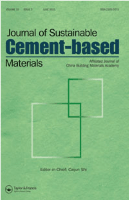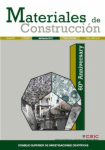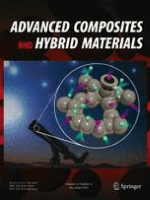
Journal of Sustainable Cement-Based Materials
Scope & Guideline
Advancing sustainable innovation in cement technology.
Introduction
Aims and Scopes
- Sustainable Materials Development:
The journal emphasizes the utilization of sustainable materials such as recycled aggregates, industrial by-products, and bio-based materials in cement and concrete production. - Durability and Performance Assessment:
A core focus is on the durability properties of cement-based materials, including resistance to environmental factors like corrosion, sulfate attack, and carbonation. - Innovative Construction Techniques:
The journal covers advancements in construction techniques, particularly 3D printing and the use of novel additives that enhance the performance and sustainability of concrete. - Self-Healing Mechanisms:
Research on self-healing properties of cementitious materials using biological and chemical methods is a significant area of interest, contributing to the longevity and maintenance of concrete structures. - Geopolymers and Alkali-Activated Materials:
The journal explores geopolymers and alkali-activated materials as alternatives to traditional Portland cement, focusing on their mechanical properties, sustainability, and potential applications. - Environmental Impact and Life Cycle Assessment:
Research that evaluates the environmental impacts of cement-based materials through life cycle assessments and carbon footprint analyses is a key area of the journal.
Trending and Emerging
- Recycled and Waste Materials:
There is a significant increase in research focusing on the use of recycled materials and industrial by-products, such as recycled concrete aggregates and waste glass, as sustainable alternatives in cement production. - Bio-Based and Self-Healing Technologies:
Research on bio-based materials and self-healing technologies is trending, with a focus on incorporating bacteria and other biological agents to enhance the durability and longevity of concrete. - 3D Printing and Advanced Construction Methods:
The use of 3D printing technology in concrete applications is gaining momentum, with studies exploring its potential to enhance structural performance and reduce material waste. - Geopolymer and Alkali-Activated Cements:
The exploration of geopolymers and alkali-activated cements is on the rise, driven by their reduced carbon footprint and innovative properties compared to traditional cements. - Environmental Impact Assessments:
There is an increasing trend in conducting life cycle assessments and environmental impact studies to evaluate the sustainability of cement-based materials and their production processes. - Nanotechnology in Cementitious Materials:
Research incorporating nanotechnology to enhance the mechanical and durability properties of cement-based materials is emerging, showing promise for future applications.
Declining or Waning
- Traditional Portland Cement Use:
There is a noticeable decline in research focused on traditional Portland cement without any sustainable modifications, as the field shifts towards more eco-friendly alternatives. - Conventional Additive Technologies:
Research on conventional chemical additives without sustainable credentials is waning, with a shift towards bio-based and environmentally friendly additives gaining traction. - Basic Mechanical Properties Studies:
Studies centered solely on the mechanical properties of cement-based materials, without considering their environmental impact or sustainability, are becoming less frequent. - Standard Curing Methods:
Traditional curing methods for concrete are being overshadowed by innovative approaches that enhance sustainability and performance, leading to a decrease in research on standard practices. - Non-renewable Resource Utilization:
Research focusing on the use of non-renewable resources in cement production is declining as the emphasis on recycling and sustainable sourcing grows.
Similar Journals

JOURNAL OF WUHAN UNIVERSITY OF TECHNOLOGY-MATERIALS SCIENCE EDITION
Elevating Materials Science to New HeightsJOURNAL OF WUHAN UNIVERSITY OF TECHNOLOGY-MATERIALS SCIENCE EDITION, published by Wuhan University of Technology, stands as a prominent platform for the dissemination of innovative research in the field of Materials Science. With an ISSN of 1000-2413 and an E-ISSN of 1993-0437, this journal is committed to advancing the understanding of material composition, properties, and applications, contributing to the broader scientific community. Since its inception in 1994, the journal has maintained a steady trajectory of growth, culminating in a Q3 category ranking in Materials Science (miscellaneous) for the year 2023, positioning it within the 33rd percentile of its peers in Scopus rankings. By embracing rigorous peer-review standards and encouraging collaborative scholarship, the journal aims to inspire researchers, professionals, and students alike to explore cutting-edge advancements within the field. Although it does not currently operate under an open access model, its wealth of knowledge remains invaluable for those seeking to deepen their understanding of materials science and its transformative impact across various industries.

MATERIALES DE CONSTRUCCION
Advancing the Science of Building MaterialsMATERIALES DE CONSTRUCCION is a leading international journal dedicated to the fields of Building and Construction, Materials Science, and Mechanics of Materials, published by the CONSEJO SUPERIOR INVESTIGACIONES CIENTIFICAS-CSIC in Spain. With a rich history dating back to 1957 as an Open Access journal, it provides an invaluable platform for disseminating research findings that advance the science and application of materials in construction and engineering. The journal, indexed in Scopus, maintains a Q2 ranking in esteemed categories such as Building and Construction, and demonstrates significant impact with its ranking placements, including #91 in Building and Construction and #197 in Mechanics of Materials. Aimed at researchers, professionals, and students, MATERIALES DE CONSTRUCCION is committed to publishing high-quality studies that reflect the latest advancements in the discipline, fostering innovation and collaboration within the scientific community. For its readers, the journal offers a wealth of knowledge accessible from anywhere, ensuring that vital research is shared and utilized across the globe.

Proceedings of the Institution of Civil Engineers-Construction Materials
Unveiling New Horizons in Civil Engineering MaterialsProceedings of the Institution of Civil Engineers - Construction Materials is a leading journal dedicated to advancing the field of civil engineering, with a specific focus on construction materials. Published by Emerald Group Publishing Ltd in the United Kingdom, this journal serves as a critical platform for disseminating innovative research and practical applications in material science and structural engineering. With an ISSN of 1747-650X and E-ISSN 1747-6518, it spans an impressive timeline from 2006 to 2024, encapsulating pivotal studies that influence contemporary engineering practices. As a Q3 journal in the categories of Civil and Structural Engineering, Materials Science, and Mechanics of Materials, it reflects a solid academic standing, holding ranks of 152 out of 379 in Civil Engineering and 171 out of 398 in Mechanics of Materials, positioning itself within the esteemed scholarly community. The journal's objectives include promoting innovative material applications and fostering collaboration among professionals and researchers in the field. Although it does not currently offer open access, its comprehensive insights and findings are invaluable for researchers, professionals, and students striving for excellence in civil engineering and materials science.

Drvna Industrija
Fostering Excellence in Forestry ScholarshipDrvna Industrija, a peer-reviewed journal published by the Zagreb University, Faculty of Forestry, serves as a cornerstone for research in the field of forestry and wood industry sciences. Established in 1980 and with a commitment to open access since 2006, this journal allows for a broad and unrestricted dissemination of knowledge, featuring original articles, reviews, and case studies that reflect the latest advancements in forestry practices and wood industry technologies. With its ISSN 0012-6772 and E-ISSN 1847-1153, Drvna Industrija is indexed in Scopus, holding a respectable Q3 quartile ranking in the forestry category, which places it in the top half of the field. As of 2023, it ranks 85th out of 174 in Agricultural and Biological Sciences with a 51st percentile, highlighting its relevance and impact in contemporary research. The journal's dedication to promoting innovative practices and fostering academic excellence continues to engage researchers, professionals, and students in Croatia and around the world, contributing significantly to the discourse on sustainable forest management and utilization of wood products.

ZKG INTERNATIONAL
Fostering Excellence in Material Engineering ResearchZKG INTERNATIONAL is a reputable academic journal dedicated to advancing research in the fields of construction and material engineering, specifically focusing on the cement and concrete industries. Published by BAUVERLAG BV GMBH, this journal serves as a vital platform for researchers, engineers, and industry professionals to share innovative findings, methodologies, and practical applications. While it does not currently operate under an open access model, ZKG INTERNATIONAL maintains a robust subscription base, ensuring wide dissemination of critical insights within the academic and professional communities. The journal also fosters a commitment to high-quality standards, reflected in its efforts to publish comprehensive reviews, original research articles, and case studies that contribute to the evolution of modern construction practices. Its ISSN 2366-1313 stands as a testament to its credibility and the importance placed on advancing the scientific discourse surrounding cementitious materials.

Resources Conservation & Recycling Advances
Shaping the future of recycling with cutting-edge insights.Welcome to Resources Conservation & Recycling Advances, an influential open-access journal published by Elsevier since its inception in 2021. With an ISSN of 2667-3789, this journal serves as a vital platform for disseminating cutting-edge research in the fields of economics, waste management, and environmental science. Recognized for its high impact, it proudly holds a Q1 ranking in both Economics and Econometrics as well as Waste Management and Disposal, highlighting its significance within these critical categories. The journal aims to advance understanding and innovation in resource conservation and recycling practices, making it an essential resource for researchers, professionals, and students dedicated to sustainability. With its current Scopus rankings placing it in the top percentiles—34th out of 716 in Economics and Econometrics and 21st out of 134 in Waste Management—Resources Conservation & Recycling Advances continues to contribute to meaningful discussions and developments in the pursuit of a more sustainable future.

JOURNAL OF CELLULAR PLASTICS
Fostering Innovation in Polymer ScienceThe JOURNAL OF CELLULAR PLASTICS, published by SAGE PUBLICATIONS LTD, stands as a significant resource in the fields of Chemistry, Materials Chemistry, and Polymers and Plastics. With an ISSN of 0021-955X and an E-ISSN of 1530-7999, this esteemed journal has been contributing to scientific knowledge since its inception in 1965 and is slated to continue its impactful publication through 2024. Ranking in the Q2 category across its respective fields in 2023, and consistently positioned within the 61st to 63rd percentile in Scopus rankings, it is recognized for disseminating high-quality research that advances our understanding of cellular plastics. Although it operates under a subscription model, the journal remains dedicated to fostering scholarly discourse and innovation, making it an essential platform for researchers, industry professionals, and students eager to explore the latest advancements in polymer science.

Materia-Rio de Janeiro
Unlocking innovative research for a sustainable future.Materia-Rio de Janeiro is a distinguished open-access journal published by UNIV FED RIO DE JANEIRO, LAB HIDROGENIO, dedicated to advancing knowledge in the fields of Chemistry, Materials Science, and Physics. Since its inception in 2006, the journal has established a platform for the dissemination of innovative research, fostering collaboration among researchers globally. The journal's commitment to open access promotes the widespread availability of valuable scientific findings, making it an essential resource for academia and industry professionals alike. With a focus on diverse disciplines, Materia-Rio de Janeiro holds a Q4 classification in multiple categories for 2023, indicating its relevance in the expansive landscape of materials research. Operating from Rio de Janeiro, Brazil, this journal serves as a vital conduit for emerging scientific insights, hence delivering impactful contributions to the global research community.

Advanced Composites and Hybrid Materials
Pioneering Research in Hybrid MaterialsAdvanced Composites and Hybrid Materials, published by SPRINGER NATURE, is a premier journal dedicated to the field of materials science, with a keen focus on innovative composite materials and their applications. With its ISSN 2522-0128 and E-ISSN 2522-0136, the journal has established itself as a cornerstone for researchers and professionals in materials chemistry, ceramics, and polymers, achieving an impressive Q1 ranking across multiple categories in 2023. In particular, it ranks #3 out of 161 in Polymers and Plastics and #4 out of 127 in Ceramics and Composites, highlighting its influential presence within the academic community. The journal aims to provide a cutting-edge platform for the dissemination of groundbreaking research and developments from 2018 to 2024, facilitating knowledge sharing and collaboration among experts. While currently adopting a traditional access model, the significance and impact of research published in this journal cannot be overstated, making it an essential resource for anyone interested in advancing the field of composite materials.

International Journal of GEOMATE
Elevating knowledge in building and environmental sciences.The International Journal of GEOMATE, published by GEOMATE INT SOC based in Japan, is a pivotal resource for scholars and practitioners in the fields of Building and Construction, Environmental Engineering, Geotechnical Engineering, and Soil Science. Established in 2011 and continuing to set the standard in its focus areas, this journal serves as a platform for innovative research and practical applications, with contributions that significantly enhance the understanding and development of sustainable engineering practices. With its current classification in the Q3 quartile across multiple categories, it strives to disseminate critical knowledge and foster dialogue among a diverse audience, including researchers, industry professionals, and students. Though operating under a traditional subscription model, the journal's emphasis on rigorous peer review and high-quality publications ensures a substantial impact factor, further reinforcing its reputation in academia. Spanning from 2011 to 2024, the International Journal of GEOMATE invites contributions that advance the knowledge frontier and address contemporary challenges in engineering and environmental science.